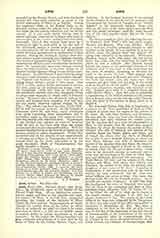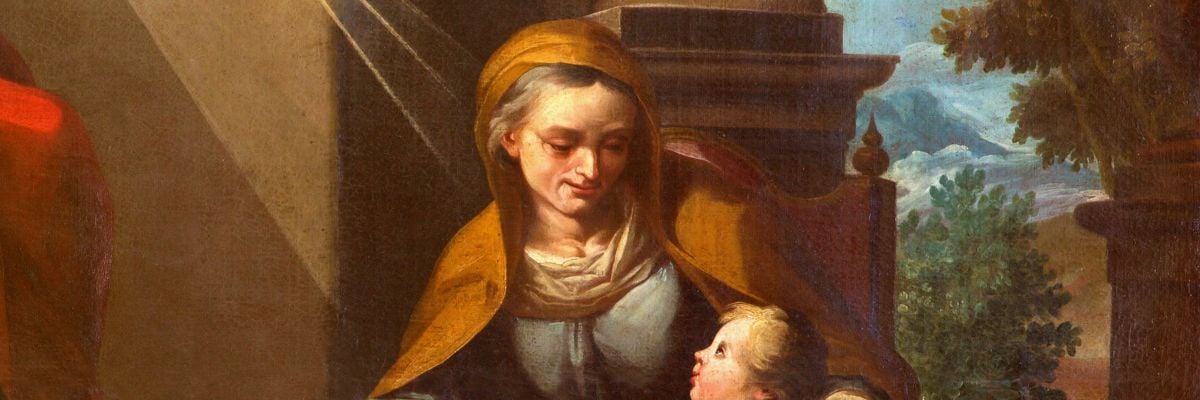

Anne, Saint (Heb., Hannah, grace), ANN, ANNE, ANNA, the traditional name of the mother of the Blessed Virgin Mary. All our information concerning the names and lives of Sts. Joachim and Anne, the parents of Mary, is derived from apocryphal literature, the Gospel of the Nativity of Mary, Pseudo-Matthew and the Protoevangelium of James. Though the earliest form of the latter, on which directly or indirectly the other two seem to be based, goes back to about A.D. 150, we can hardly accept as beyond doubt its various statements on its sole authority. In the Orient the Protoevangelium had great authority and portions of it were read on the feasts of Mary by the Greeks, Syrians, Copts, and Arabians. In the Occident, however, it was rejected by the Fathers of the Church until its contents were incorporated by Jacobus de Voragine in his “Golden Legend” in the thirteenth century. From that time on the story of St. Anne spread over the West and was amply developed, until St. Anne became one of the most popular saints also of the Latin Church.
The Protoevangelium gives the following account: In Nazareth there lived a rich and pious couple, Joachim and Hannah. They were childless. When on a feast day Joachim presented himself to offer sacrifice in the temple, he was repulsed by a certain Ruben, under the pretext that men without offspring were unworthy to be admitted. Whereupon Joachim, bowed down with grief, did not return home, but went into the mountains to make his plaint to God in solitude. Also Hannah, having learned the reason of the prolonged absence of her husband, cried to the Lord to take away from her the curse of sterility, promising to dedicate her child to the service of God. Their prayers were heard; an angel came to Hannah and said: “Hannah, the Lord has looked upon thy tears; thou shalt conceive and give birth, and the fruit of thy womb shall be blessed by all the world”. The angel made the same promise to Joachim, who returned to his wife. Hannah gave birth to a daughter whom she called Miriam (Mary). Since this story is apparently a reproduction of the biblical account of the conception of Samuel, whose mother was also called Hannah, even the name of the mother of Mary seems to be doubtful.
The renowned Father John Eck of Ingolstadt, in a sermon on St. Anne (published at Paris in 1579), pretends to know even the names of the parents of St. Anne. He calls them Stollanus and Emerentia. He says that St. Anne was born after Stollanus and Emerentia had been childless for twenty years; that St. Joachim died soon after the presentation of Mary in the temple; that St. Anne then married Cleophas, by whom she became the mother of Mary Cleophae (the wife of Alphleus and mother of the Apostles James the Lesser, Simon and Judas, and of Joseph the Just); after the death of Cleophas she is said to have married Salomas, to whom she bore Maria Salomae (the wife of Zebedaus and mother of the Apostles John and James the Greater). The same spurious legend is found in the writings of Gerson (Opp. III, 59) and of many others. There arose in the sixteenth century an animated controversy over the marriages of St. Anne, in which Baronius and Bellarmin defended her monogamy. The Greek Mena (July 25) call the parents of St. Anne Mathan and Maria, and relate that Salome and Elizabeth, the mother of St. John the Baptist, were daughters of two sisters of St. Anne. According to Ephiphanius it was maintained even in the fourth century by some enthusiasts that St. Anne conceived without the action of man. This error was revived in the West in the fifteenth century. (Anna conce pit per osculum Joachimi.) In 1677 the Holy See condemned the error of Imperiali, who taught that St. Anne in the conception and birth of Mary remained virgin (Benedict XIV, De Festis, II, 9). In the Orient the cult of St. Anne can be traced to the fourth century. Justinian I (d. 565) had a church dedicated to her. The canon of the Greek Office of St. Anne was composed by St. Theophanes (d. 817), but older parts of the Office are ascribed to Anatolius of Byzantium (d. 458). Her feast is celebrated in the East on the 25th of July, which may be the day of the dedication of her first church at Constantinople or the anniversary of the arrival of her supposed relics in Constantinople (710). It is found in the oldest liturgical document of the Greek Church, the Calendar of Constantinople (first half of the eighth century). The Greeks keep a collective feast of St. Joachim and St. Anne on the 9th of September. In the Latin Church St. Anne was not venerated, except, perhaps, in the south of France, before the thirteenth century. Her picture, painted in the eighth century, which was found lately in the church of Santa Maria Antiqua in Rome, owes its origin to Byzantine influence. Her feast, under the influence of the “Golden Legend”, is first found, (July 26) in the thirteenth century, e.g. at Douai (in 1291), where a foot of St. Anne was venerated (feast of translation, September 16). It was introduced in England by Urban VI, November 21, 1378, from which time it spread all over the Western Church. It was extended to the universal Latin Church in 1584.
The supposed relics of St. Anne were brought from the Holy Land to Constantinople in 710 and were still kept there in the church of St. Sophia in 1333. The tradition of the church of Apt in southern France pretends that the body of St. Anne was brought to Apt by St. Lazarus, the friend of Christ, was hidden by St. Auspicius (d. 398), and found again during the reign of Charlemagne (feast, Monday after the octave of Easter); these relics were brought to a magnificent chapel in 1664 (feast, May 4). The head of St. Anne was kept at Mainz up to 1510, when it was stolen and brought to Duren in Rheinland. St. Anne is the patroness of Brittany. Her miraculous picture (feast, March 7) is venerated at Notre Dame d’Auray, Diocese of Vannes. Also in Canada, where she is the principal patron of the province of Quebec, the shrine of St. Anne de Beaupre is well known. St. Anne is patroness of women in labor; she is represented holding the Blessed Virgin Mary in her lap, who again carries on her arm the Child Jesus. She is also patroness of miners, Christ being compared to gold, Mary to silver.
FREDERICK G. HOLWECK


